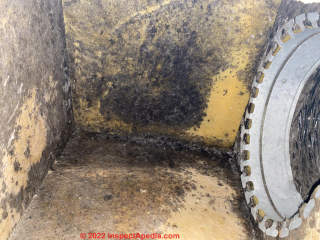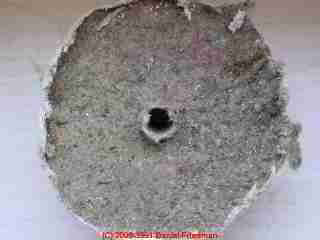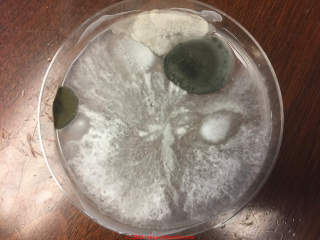 Indoor Air, Gas, Odor or Mold Emergency?
Indoor Air, Gas, Odor or Mold Emergency?
When & How to Hire an Expert
- POST a QUESTION or COMMENT about how to hire a mold or other environmental test & inspection expert & about to decide if a mold, odor or other indoor air emergency exists, what to do in an emergency, and how to determine if professional mold inspection & testing are needed
When and how to hire an expert to inspect & test a building for environmental, health, safety, mold, IAQ hazards, or to test for mold or other building contaminants.
This article describes how to determine that you should hire an expert for on-site mold or other indoor contamination inspection and testing. We also discuss how to find and choose the proper expert to perform inspections and possibly tests to help decide if you need professional remediation services.
Not every environmental, safety, or mold contamination worry merits a costly onsite investigation - hiring an onsite expert or even performing mold testing for trivial mold cleanup jobs is expensive and usually unnecessary.
But failing to hire an expert when one is needed can itself be a costly mistake of a different kind.
InspectAPedia tolerates no conflicts of interest. We have no relationship with advertisers, products, or services discussed at this website.
- Daniel Friedman, Publisher/Editor/Author - See WHO ARE WE?
How to Decide When to Hire an Environmental or Mold Inspection / Test Professional
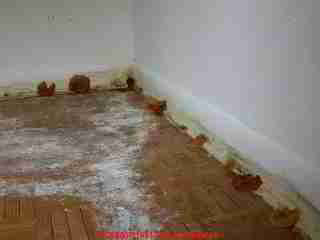
The purpose of the advice below is to help readers decide when it is appropriate to perform mold inspection and testing on a building.
We want to know how and when mold testing is appropriate, and we want to avoid spending money on mold testing when it is not necessary. Also we want to avoid spending money on unreliable mold "tests" and inspections that do not validly support any conclusion about the building.
Our moldy home photograph (left) shows a cup fungus growing along the wall/floor baseboard trim in a home that had suffered a prolonged plumbing leak.
The visible fungal growth is quite obvious. What is less obvious, and what will require an expert inspection, is the extent of mold cleanup needed in the building, possibly including hidden mold in wall and ceiling cavities.
The answer to the "when to hire an expert" question hinges on the answers to the questions given in the table below. Or if you don't like decision tables try our "expert hiring RULES of THUMB" that follow the table.
Article Contents:
When to Hire a Mold or Environmental Inspector: Decision Table |
||
|---|---|---|
| Question | ||
| Is there an indoor air quality emergency? | Yes: immediately get outside into fresh air, notify building occupants, seek help; Examples might include - people are becoming sick or overcome or having difficulty breathing when they are in the building - there are odors of a gas leak such as propane, LP gas, natural gas or sewer gas Urgent action: also includes people in the building are at extra risk of respiratory illness such as asthmatics, immune-compromised, elderly, infant, AND there is a large (more than 30 sq ft) visible mold reservoir in the building |
|
No: whether or not you need an expert depends on the questions & answers below. If you are not sure if an emergency exists check out the articles listed at right. |
||
| Large visible mold area: Is there a large area of visible, non-cosmetic mold in the building - more than 30 sq.ft. of contiguous mold of any color or texture? | Yes: you need a professional to define the scope of cleanup needed and to explain how to correct the cause of indoor mold contamination. |
MOLD DETECTION & INSPECTION GUIDE MOLD APPEARANCE - WHAT MOLD LOOKS LIKE |
No: whether or not you need an expert depends on the questions & answers below. |
||
Mold "Test" Results: do results of a mold screening test, air test, surface test, or culture test suggest that indoor mold contamination is present? |
Yes: provided that the mold screening test was properly conducted and has reasonable validity, you need a professional to define the scope of cleanup needed and to explain how to correct the cause of indoor mold contamination. Watch out: because it is possible to find some mold growth in just about any building, collecting a sample of such mold from what is actually a trivial or small area of indoor mold contamination would not, of itself, justify a costly and extensive building mold investigation. |
AIRBORNE PARTICLE & MOLD COUNT NUMBER GUIDE U. MINNESOTA RULES discuss levels of mold contamination & other factors. |
No: Watch out: while a "positive" mold test result can indeed suggest that a hidden mold problem is present in a building, negative results on just about any mold test cannot assure that no problematic mold reservoir is present. Whether or not you need an expert depends on the questions & answers below. |
ACCURACY OF AIR TESTS for MOLD AIRBORNE PARTICLE & MOLD COUNT NUMBER GUIDE MOLD CULTURE TEST KIT VALIDITY |
|
Other evidence of an IAQ problem: is there other evidence of an indoor air quality problem such as building-related occupant complaints |
Yes: hire a professional to identify & investigate building areas of highest risk of a hidden or non-visible problem or hazard |
ALLERGENS in BUILDINGS, RECOGNIZING FLOODS in BUILDINGS, MOLD PREVENTION INDOOR AIR QUALITY & HOUSE TIGHTNESS |
No: whether or not you need an expert depends on the questions & answers below. |
||
Other high risk factors: are there other high risk factors such as vulnerable building occupants, non-specific building-related health complaints, or a history of building leaks or floods |
Yes: hire a professional to identify & investigate building areas of highest risk of a hidden or non-visible problem or hazard |
FIVE RULES of THUMB help decide if a building investigation is warranted |
No: most likely a building investigation and further testing for mold contamination are not justified. |
||
This table is part of a series of advisory steps about mold contamination investigation found
at MOLD / ENVIRONMENTAL EXPERT, HIRE ?.
Five reasons to consider a more extensive on-site investigation for toxic or allergenic mold
Five Rules of Thumb for Deciding When to Hire a Professional to Inspect for Mold & Prepare a Mold Remediation Plan
- People in the building are at
particular health risk:
elderly, infant, immune-impaired, asthmatic, history of respiratory illness or other medical complaints which might be caused by or aggravated by mold, allergens, or other bioaerosols - People in the building are sick
and there is reason to suspect that the building is causing or contributing to health, air quality, or similar concerns. You need a building or apartment evaluation and diagnosis to answer the question that may be posed by your doctor: might the building be contributing to or causing these complaints? - The building has or is
suspected of having had a history of significant leak events
or even a single event which flooded some areas: plumbing leaks, roof leaks, ice dam leaks, basement water entry, sewer backup, ventilation problems, air conditioning system problems; forced-air central heating/cooling concerns.
If hidden building cavities have been wet, the mold you see may be just the tip of a "mold iceberg" that does need an expert to find the extent of mold, cause of mold, and to remove the mold. - Large areas of water damage or mold contamination have
been seen and you need an estimate of the extent of demolition
and mold remediation which will be needed to make a proper cleanup and repair.
Small mold problems:
If you are confident that the amount of mold is less than 30 sq. ft. of contiguous mold (and that there is no significant risk of a larger hidden mold problem) then the NY City mold remediation guidelines suggest that professional remediation is not appropriate.
You do not need to hire someone other than perhaps a handyman or general cleaning service. BEWARE: if during cleanup of a small mold problem you discover that it is actually a large one, stop work and bring in a professional to advise you on how to proceed.
Large mold problems:
If more than 30 sq. ft. of mold-infected material is found or is already visible, then you need professional advice as more serious health risks and mold contamination may be involved. - Contractors have already bid a variety of expensive mold-cleanup approaches
to building cleanup/remediation and you need an unbiased, informed professional to help sort out these proposals
U. Minnesota general rules of thumb for deciding when to inspect for mold
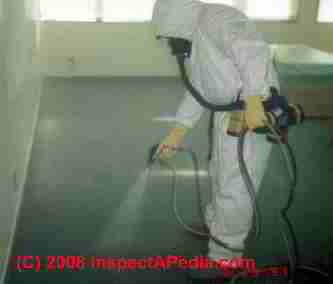 [Edited and annotated by Daniel Friedman.]
[Edited and annotated by Daniel Friedman.]
IF these conditions are present in a building being evaluated for mold contamination risk
- Fungal spore count or visual
presence indicators are high (air or bulk)
[DF comment: BEWARE: while a high indoor spore count probably does indicate a problem, a low indoor airborne mold count is not a reliable clean bill of health for a building.
See ACCURACY OF AIRBORNE MOLD SPORE COUNTS.] - Fungi indoors are different
from outdoors
or non-complaint control areas. - Fungi are allergenic or toxic
- many but not all molds found indoors are potentially harmful or dangerous - The area is likely to be disturbed
- There is or was a source of
water or high relative humidity,
AND - People are occupying the area
or have contact with air from this area - There are immune compromised
individuals
or individuals with elevated sensitivity to molds
[DF Comment: we add other examples of people at special risk: elderly, infant, asthmatic, COPD sufferers]
THEN mold may be a problem in the building. -- N. Carlson, U. Minnesota [Comments added by DF]
Research on Hiring an Environmental or Mold Expert Consultant
- ANSI Standard & Institute of Inspection Certification (2008). S520 Standard and Reference Guide for Professional Mold Remediation. Website: https://webstore.ansi.org/ Provided to ANSI by the Institute of Inspection, Cleaning and Restoration Certification [IICRC], cited below. Web: https://iicrc.org/
- Light, Ed, J. Bailey, and R. Gay. NEW PROTOCOL FOR THE ASSESSMENT AND REMEDIATION OF INDOOR MOLD GROWTH [PDF] In Proceedings of 12th International Conference of Indoor Air Quality and Climate, vol. 1, pp. 163-168. 2011.
Summary:
The effectiveness of current response procedures for addressing mold growth is evaluated, and the authors recommend a new protocol for building assessment and remediation. Assessment based primarily on mold testing has significant limitations and may fail to identify sites with mold growth.
Microbiological testing is replaced by engineering evaluation with a focus on site moisture dynamics.
Critical performance objectives for remediation are to restore the site to conditions preceding water damage while preventing occupant exposure to airborne mold generated by the repair process. Hazardous material abatement procedures are generally not needed for mold remediation. - Robinson, Christine. THE ASSOCIATIONS BETWEEN MOLD REMEDIATION PRACTICES AND POST-REMEDIATION VERIFICATION TESTING FOR RESIDENTIAL STRUCTURES IN SOUTHERN CALIFORNIA FROM 2008 TO 2019 [PDF] PhD diss., Trident University International, 2020. - This graduate work has been published as open access.
Excerpt:
The purpose of this study was to determine the correlations between how closely water damage mitigation and mold remediation work follows consensus guidelines and the results of Indoor Environmental Professional assessments, especially mold spores. - Schaible, Ronald D. THE ROLE OF THE INDOOR ENVIRONMENTAL PROFESSIONAL IN MOLD REMEDIATION [PDF] In ASSE Professional Development Conference and Exposition. OnePetro, 2005. - retrived 2022/06/05 original source: https://www.jurispro.com/files/articles/Schaible-asse.pdf
Excerpts:
Introduction
The nature of mold contamination and subsequent remediation (sometimes also referred to as "restoration") requires adherence to consistent techniques and protocols to successfully and effectively restore a structure for human occupancy. Until recently, the qualifications and role of the Indoor Environmental Professional (IEP) in this process were fluid. Recent guidance documents and standards now provide some structure and clarity to the IEP's contribution to successful mold remediation. Litigation has also elevated the standard of care for all parties involved with mold remediation.
This paper provides perspectives on the role of the IEP in mold remediation, with particular emphasis on the IEP's responsibility to bring clarity from complex issues due to the lack of definitive criteria for performing pre- and post-remediation activities.
What Is An Indoor Environmental Professional?
Published minimum qualifications and professional competencies have become more widespread as the issue of mold remediation and the broader spectrum of indoor air quality has gained prominence. Sound professional judgment is necessary as there is no current regulation of mold.
This is due to the numerous and complex issues involved in establishing causal relationships between exposure and health response. Various states have passed, or have attempted to promulgate legislation governing the qualifications and activities of mold assessors and the companies for whom they work, as well as remediation companies.
Some states have initiated studies of the health effects of mold toxicity and have established criteria under which damages may be sought with respect to mold exposure.
...
The IICRC (2003) states that "The role of an IEP is to perform an assessment of the fungal ecology of property, systems and contents at the job site, create a sampling strategy, sample the indoor environment, interpret laboratory data and determine Condition 1, 2 and 3 status for the purpose of establishing a scope of work (pre-remediation assessment) and/or when necessary to verify the return to normal fungal ecology."
...
Reader Comments, Questions & Answers About The Article Above
Below you will find questions and answers previously posted on this page at its page bottom reader comment box.
Reader Q&A - also see RECOMMENDED ARTICLES & FAQs
On 2022-10-28 by InspectApedia-911 (mod) - how can I find the right home inspector or mold inspector?
@Allison,
I agree that navigating "whom to hire" for environmental inspections, mold inspections, water or leak damage inspection in a private home or rental apartment is difficult, and that the success and ease of finding someone competent and helpful will vary by location.
First about doing your own tape test
Although at TEST KIT for DUST, MOLD, PARTICLES: INSTRUCTIONS
we explain how to do that, (and many test labs across North America and the UK, Australia, New Zealand, etc. will accept such samples - it doesn’t have to be a local lab ) for mold questions, such testing is not generally needed. You can easily recognize a large moldy area if one is visible in your building.
Or see MOLD APPEARANCE - WHAT MOLD LOOKS LIKE
Knowing the genera/species of mold doesn’t change the cleanup needed.
Where settled dust tests are more useful are in screening building dust for particles that indicate a less obvious hazard - penicillium spore chains, unusual levels of dust mites or allergens, asbestos, or cross-contamination from a prior cleanup job.
Occasionally such tests are useful for someone’s doctor who is diagnosing an allergic or other health problem and who wants to know what was in the person’s environment.
About hiring an inspector:
Too many "mold inspectors" simply drop by to do some sort of "test" that - by itself - is of little real value. Even if the test says there's a problem, it's not diagnostic: where is the problem, what's needed?
Too many home inspectors will also "just do a test".
A good home inspector is expert in finding a building's leak history, noticing building or mechanical system features that are likely to result in leaks or trapped moisture, and at taking a building's leak history and construction materials into account in assessing the risk of hidden mold reservoirs, even if the focus is on moisture, not mold.
A home inspector who won't open an air handler is not a true, licensed, competent inspector, since opening the mechanical systems like air handlers is a fundamental requirement of home inspection standards.
The inspector is expected to open those covers and access panels designed and intended for inspection or service of air handlers, furnaces, electrical panels, etc.
Refusal to do that is as egregious error as skipping inspection of an attic or basement or of some rooms in a building. An exception is, of course, provided if the inspector feels that entering an area or touching equipment is unsafe. But even in that case s/he is required to tell you of that limitation and to explain its implications.
In some cities people bill services as an environmental inspector who looks for visually detectable environmental hazards like mold and lead paint, who documents the findings, and who might make limited use (as it's value is limited) of testing.
An industrial hygienist is overkill for mold inspections in a rental home and worse, may be inexpert in building science and over reliant on testing.
Few, if any, environmental test labs offer inspection services, and even among those their inspectors are likely to be too uneducated in building science and over reliant on profitability.
CONSULTANTS & EXPERTS DIRECTORIES
has some suggestions though these lists are of, course, not comprehensive. You can also try web searching for environmental inspector or mold inspector or home inspector in your city, but as we've discussed, you need some conversation with an inspector before hiring someone.
Spend some time on the telephone calling home inspectors and environmental inspectors and perhaps an experienced HVAC company who offers duct inspection by cameras. You may need, in the worst case, to hire two different people.
After describing your concern and what you think are your needs, ask the inspector if, for example, she inspects the air handler (blower compartment, insulation, blower fan) for visible mold or water leakage.
If the inspector gives an answer with any thoughtful content whatsoever I’d be encouraged.
I’m reluctant to hire someone who just tosses a “report” over the wall and moves on with no support to his/her clients.
If the inspector says no, or if he gives a vague arm-waving answer like "don't worry about it, honey, we'll take care of everything" then it's time to call someone else - for two reasons in the case of my example.
On 2022-10-28 by Allison - having trouble identifying a home inspector
@InspectApedia (Editor),
How do I find a suitable environmental inspector for my mold in my contaminated HVAC system and maybe elsewhere?
I can't tell you how thankful I am for your thorough and informative (and speedy!) response. I regret that I did not come across your site months ago. I'm an epidemiologist by training and know just enough relevant science to be dangerous.
I understand the risks of mishandling the situation but wading through the evidence and misinformation has been overwhelming and I've agonized over the best course of action. Thank you so much for helping consumers like me.
One follow-up question, if you can spare additional time.
Regarding whom to hire:
When exploring HVAC mold, would you be inclined to recommend hiring a home inspector who is proficient in multiple building systems including HVAC systems but who might not have as much experience with mold, or a mold inspector who is more proficient in effective inspection and testing protocols but does not have a mechanical license?
Given local licensure requirements when HVAC systems are involved, I've not been able to find a mold inspector who will do more than simply inspect visible components (i.e., they will not open the air handler).
I've also had trouble identifying a home inspector who:
1) works with renters, and
2) appears to have much mold-specific experience.
Are there any professional certifications or association memberships I could be on the lookout for?
I'm tempted to try my own tape/dust sampling while I'm searching for the right professional but don't see any local labs that seem to offer direct-to-consumer services.
On 2022-10-27 by InspectApedia (Editor) - must replace ductwork not just clean
@Allison,
This photo is of mold on louvers of what may be an air supply register - not by itself a major health concern but quite possibly an indicator of more extensive mold contamination.
While a register like this can be cleaned (or easily replaced) one should not do so without further investigation of the condition of the duct work and air handler.
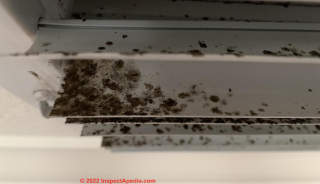
posting more of your photos of moldy HVAC air handler and ductwork
In these photos, where one is of the round flex duct, note that this photo of flex duct shows a gray deposit on the duct interior.
Such deposits are normal and are usually made principally of house dust: fabric fibres & skin cells - not harmful themselves, but a ready invitation to mold growth if the duct interior is damp or wet.
This type of ductwork cannot be cleaned - it would have to be replaced.
On 2022-10-27 by InspectApedia (Editor) - HVAC mold in vents, ductwork, and building
@Allison,
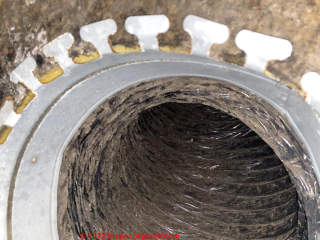 IMO your landlord did exactly the right thing by replacing the badly-contaminated moldy air handler and ductwork.
IMO your landlord did exactly the right thing by replacing the badly-contaminated moldy air handler and ductwork.
The contractor may not have performed the work properly if they spread moldy debris and dust in the building, and there is a second and very expensive risk that thereby the new HVAC system., air handler and ductwork are already mold-contaminated.
Just how serious that new contamination is ranges from trivial to serious depending on its extent and also on just how wet or dry is the air handler (thus discouraging or encouraging mold growth on its interior surfaces - a problem that can show up as early ins 24-48 hours).
I would never rely on air tests nor culture tests: the possibility of a false negative result (no mold problem) is far too great. 90% of molds won't grow in culture and air tests vary in "count" for the identical situation by as much as 4 orders of magnitude depending on small changes in test conditions.
I can only guess at what's needed as I've almost no information about your building and HVAC system, but most likely what's needed is a thorough visual inspection, some tests of settled dust in the occupied spaces and in the HVAC system on its surfaces, and if those show meaningful mold contamination, further professional cleaning, THEN followed by a clearance inspection and test, would be needed.
We include some additional moldy HVAC air handler and ductwork photos from your private email.
Keep us posted and ask further questions as you wish.
On 2022-10-27 by Allison
I’m grateful to have found this resource. I moved into a rental home in April and identified what appeared to be mold in the HVAC vents and a musty smell from certain vents when the system came on. After a lot of back and forth my landlord eventually agreed to have a mold inspector take a look.
They did not do a particularly thorough inspection, focusing mostly on the vents and ducts and taking air samples, but they did find obvious mold. I’ve a picture of the inside of one of plenums; they all looked similar.
They determined that the HVAC unit was oversized and not dehumidifying appropriately – a pretty bad thing regardless but especially given that the house is directly on the water in Florida.
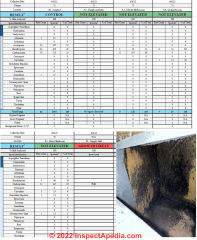 The air samples were generally fine (see the image; 0 spores of the most harmful genera with small amounts of Cladosporium, Basidiospores, Curvularia, and some others), but a swab sample inside the air ducts unsurprisingly found high levels of active Cladosporium growth.
The air samples were generally fine (see the image; 0 spores of the most harmful genera with small amounts of Cladosporium, Basidiospores, Curvularia, and some others), but a swab sample inside the air ducts unsurprisingly found high levels of active Cladosporium growth.
My landlord elected to have all of the ductwork and the air handler and compressor replaced, as well as added on an in-unit air purifier and UV lights. Great news, right?
However, the HVAC contractor they used did not follow any containment protocols despite my protests, left dust and moldy insulation/debris throughout the house, and did not even replace the air filters that were in place prior to the “remediation”.
Allergy testing has indicated that I’m highly sensitive to much mold and my allergies are still terribly flared up. I therefore have little faith that the mold is gone and am afraid that they may have just made the problem worse.
The contractor was supposed to have a mold inspector come retest but it’s been 4 months now so I’m not expecting they’ll send anyone, nor would I trust whoever they send.
I’m not sure what to do at this point. Would you recommend having a clearance inspection done? What should I have them look for? Is simply confirming the HVAC system looks clean sufficient?
I know air sample tests are not all that reliable, but would there be value in having a sample or two tested to compare to the pre-replacement report? I don’t feel safe and am willing to spend money for peace of mind, but I want to spend it smartly.
My landlord does seem committed to solving the problem, as they will be moving into the home after my lease ends, but I’m afraid they have fallen into the trap of going with the cheaper contractor and taking the less expensive route that ultimately is going to cost them more.
On 2021-10-30 by inspectapedia.com.moderator - how dangerous is the mold growing on my ceiling
@Frank,
There is no reasonable probability that the collection of various mode genera and species that you see growing on drywall or plaster in that space is harmless.
It's likely to contain small spores such as aspergillus or penicillium that can be quite dangerous.
And of course you are only seeing the mold on the surface, and we don't know, because we don't know it's cause, how much mold is growing hidden in ceiling and wall cavities.
On 2021-10-30 by Frank
I'm an engineer. I study multiphase flows, including aerosols. I have this wonderful group of molds growing in the main bedroom of an apartment I rent. I've sealed off the room and never enter without a mask.
I'm looking for a "SWAG" as to how dangerous, or not, this stuff is. Like a said, just a SWAG. If you've worked in a certain field for more than a decade, your first SWAG is usually accurate.
Thank you, I ask you to keep the following between us for now. I'm an engineer and have done research on airborne particulates most of my career. So I believe I can find a way to protect myself, at least temporarily. Frank
On 2020-09-25 by danjoefriedman (mod) - will bleach fix my mildew and mold
Tiffany
Bleaching mold is an understandable reaction, I've used it too, but it's incomplete and not quite right. The object isn't to "kill" the mold (you cannot kill all the spores, and you risk leaving "dead" but still "toxic" materials on the surface).
The object is to remove the mold.
So if there's a lot of fresh mold growth on the home you might want to power wash with deck cleaner and let everything dry completely before covering it over.
Search this website using the search box above to find our articles on
USING BLEACH TO KILL MOLD
and
CLEAN MOLD FROM WOOD SURFACES
On 2020-09-25 by Tiffany Littlepage
We are located in Houston Texas. Started an addition to our house last week. We are using yellow pine. We had rain for two straight days. The osb and the velvet were on the house but the frame was ultimately open with osb on one side of the house and doors and windows still needing to be put in.
I noticed mold or mildew on the wood a couple of days after the rain. I put bleach on it which it helped but I also noticed it on the rafters.
Guess my question is should I have the guys just spray the whole place with bleach or have a professional come
Question: how do I get someone to make a proper determination of my home's mold issue?
I have a mold allergy and would like to remediate but properly. I need to make sure that what my 2nd floor has is actually mold most likely from an old leaking of the front loading washer .... It really doesn't look too bad with some minimal cupping of the floor happening within 3 feet. Other than that the floor is and looks fine. They did cut the floor so now the washer is sitting on just subfloor that's the only area that was cut. We are getting a new washer and dryer installed and I can send you pics of that as well.
My question is I've contacted a bunch of mold remediation companies and they don't want to test or check the subfloor properly.
I stumbled upon your website and have actually wanted to confirm that this testing found on your website and checking both floor and subfloor for mold by drilling a hole actually seems fine to me as long as I know that there wasn't extensive leakage past the subfloor cut out of the washer machine and a couple of planks that looked moldy.
I don't really like the flooring and may want to just remodel and check all the subfloor using one of the mold remediation inspectors who said I don't need to worry about it (I had them use the moisture meter and it checks out fine that there is no leaking so it must have been past water damage.)
Just because I have a bad mold allergy I want to remediate though. Do you have any recommended people in ... that you could recommend I should ask who could do a proper inspection?
I am asking because you seem to know what you're doing in terms of inspection and I wanted to get your opinion on how I could get some one to determine my mold issue properly. - Anonymous by private email 2021/10/13
Moderator reply: how to find and choose a mold or other environmental inspection and testing expert
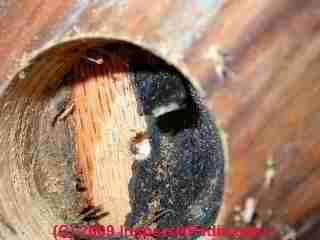 As you did not provide any photographs, for other readers we include an example here of a typical test cut made into flooring from below.
As you did not provide any photographs, for other readers we include an example here of a typical test cut made into flooring from below.
By examining the test cut plug layers and the exposed underside of the finish flooring we can see if there is evidence of floor damage or mold.
Before hiring a mold remediator it makes sense to have an assessment of the extent of mold contamination and need for remediation performed by an expert who has absolutely no business or financial relationship with the company who would perform the work. That assures you that there is no conflict of interest.
You should understand that because the mold inspector will not normally perform extensive invasive inspection such as tearing open an entire wall, floor, or ceiling, when the work is actually performed, the remediator's crew may discover that the scope of cleanup needed is more than could be seen at the initial inspection.
Watch out: you and your onsite experts will want to balance the risk of insufficient investigation or mold remediation against tests of reasonableness: it's virtually never necessary nor appropriate to have someone dash about through a building like a madwoman with an axe, chopping holes everywhere. Choice of spots for more-invasive inspection for hidden needs to be based visual evidence and the building leak history.
We go to the most-suspect areas and examine those, using invasive methods if necessary; If the most-suspect areas do not reveal hidden mold contamination on closer inspection that's not an iron-clad guarantee that there could not be a hidden problem elsewhere, but it is a reasonable place and time to stop.
Cleanup should continue to remove all visible mold or mold-contaminated materials, clean exposed surfaces, and fix the cause of mold growth such as water leaks or moisture traps.
Our photo below shows mold found on the wall cavity side of drywall that looked perfectly clean on its room-side.
You can find mold and other environmental experts using the
page top EXPERTS DIRECTORY or by simply searching for and calling some experts who are located close to your building or city.
Talk with your environmental expert about your concerns and listen for the level of thoroughness of inspection that will be performed and for a promise of both a written report and a willingness to answer follow-up questions that you may have.
Do not hire someone who is simply going to stop by to perform mold "tests" - such tests, alone, would be of very little value unless accompanied by an expert and thorough visual inspection of the entire building for visible mold and for evidence of water leaks, a taking of the building's history of leaks, repairs, modifications, and a discussion of any particular health risks or vulnerabilities of the building occupants.
About the possibility that there is hidden mold trapped between layers of flooring or sub-flooring, that's a sticky issue that can be resolved with minimum cost and disturbance by some strategic probing that we describe
at HIDDEN MOLD in FLOOR / SUB-FLOORING
Our photo (above) shows one method of checking for mold between flooring layers - when other evidence justifies making test cuts from below.
Also see HIDDEN MOLD, HOW TO FIND - home.
On 2020-06-06 - by (mod) - are the conditions in this crawl space indicative of a problem?
 Dan
Dan
Thank you for the question and photo. With the relcama that nobody can be as smart in diagnosing a building from a single photo and not a shred of other information about the building as can be a competent on-site home inspector or experienced contractor,
[Click to enlarge any image]
In your photo I see
- evidence of leaks at the far wall, perhaps a rim joist,
- water stained and somewhat delaminated plywood subfloor,
- an OSB I-joist that is quite moldy,
- darkened top and bottom chords of the I-joist from water stains,
- splits an possibly rot in the top chord of the I-joist,
- insulation trapped on nails through subfloor suggesting insulation was removed from this area - more is along the bottom of the photo,
- and at left in the photo I see what looks like a site-built add-on floor support, such as one might build to replace a damaged I-joist or to add support below a sagging or damaged floor above;
- I also see unsupported wiring, though I can't tell if it's carrying line voltage or if it's phone or ethernet cable.
The substantive questions that would shift from a concern for a local mold and leak and damage problem to a larger and more-costly repair with potentially more-harmful mold contamination include:
- How extensive is this damage, rot, mold
- What is the cause of leakage or water entry that we see. Perhaps water entry around the back entry door?
- What other repairs have been done, and by whom, with what expertise
If I had been asked to build or insert what looks like added support in the left side of your photo, I'd have warned the owner about these other observations and would have raised a concern for the possibility of more-extensive damage that certainly deserves investigation.
You say you just bought this home. Have you taken these concerns to your home inspector. She or he, having spent hours at the home inspecting everything, ought to be able to help you sort out the extent and cause of damage and the need for further repair and mold cleanup.
On 2020-06-06 22 by Dan - in the basement and there is a damp musty smell
We've just bought a house and had a look in a crawlspace in the basement and there is a damp musty smell, as well as a large dark patch on the far end. The crawlspace is located beneath the backdoor staircase. Is this a cause for concern?
On 2020-05-09 by (mod) - is this mold contamination? Do I need to hire an Expert?
 Yes, that looks like mold B.Mak.
Yes, that looks like mold B.Mak.
At both the bottom and top edges of wood trim.
More, the extent of rot and peeling paint is a warning that this area has been wet and rotting for some time, so you will want to investigate further the path of water and the extent of mold to be removed.
I would remove the rotted trim, follow the water, identify the leak source, and see just how much damage there is that needs repair.
If you find a 30 sq.ft. or larger area of mold OR if your situation meets other criteria listed above on this page then it's time to hire a professional.
On 2020-05-09 by bMak
My tenant sent me attached image of kickboard under the bathroom vanity.
The paint came off and the wood seems spongy. Is that black color thing mold (on bottom & top edges) ?
If so, would you be able to tell by looking at picture what type and how serious it could be?
Is it worth to do mold inspection or hire professional to address it or a handy man can remove a kickboard, clean it thoroughly, let it dry and install new kickboard? There is no other sign of mold anywhere else.
On 2020-03-05 - by (mod) - Building mold contamination testing by culture and settlement plates is about 90% "wrong" from the get-go
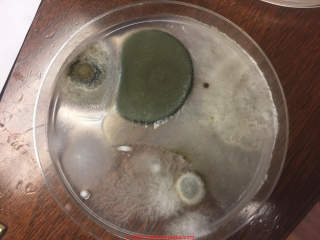 Samuel,
Samuel,
Mold testing by culture and settlement plates is about 90% "wrong" in that only about 10% of all of the millions mold genera/species will grow in any culture under any condition whatsoever.
Furthermore what falls out of the air onto a petri dish is largely affected by individual particle size and mass. So what grows is what likes the culture medium and what fell fastest out of the air.
From just a culture plate we can not know if there is a large, small, or no indoor mold contamination, event though the culture produced mold.
If you think there is a mold problem in your building you may need a more-expert inspection, history taking, etc.
If it is justified, what's useful is a thorough inspection by an expert
First see the decision table found
in on this page for help in deciding if it's appropriate to bring in an expert.
More details are at MOLD CULTURE TEST KIT VALIDITY
On 2020-03-05 by Samuel - do these pics of mold in my office mean I need further expert help
Can anyone tell me if these pics of mold in my office need further expert help. Thanks
...
Continue reading at DEFINITION of MOLD EMERGENCY or select a topic from the closely-related articles below, or see the complete ARTICLE INDEX.
Or see MOLD ENVIRONMENTAL EXPERT HIRE FAQs questions & answers about hiring an expert, posted originally at this article
Or see these
Recommended Articles
- ASBESTOS TESTING LAB LIST
- CHOOSE a FLOOD DAMAGE RESTORATION or MOLD REMEDIATOR
- HOW MUCH SHOULD YOU PAY for professional inspection or testing services?
- INDOOR AIR QUALITY IMPROVEMENT GUIDE
- MOLD / ENVIRONMENTAL EXPERT, HIRE ? - when to hire an expert
- MOLD TESTING METHOD VALIDITY
- ODORS GASES SMELLS, DIAGNOSIS & CURE
- OTHER PEOPLE's MONEY - watch out for experts whose advice is principally designed to protect themselves at your expense
- UNSAFE ENVIRONMENT, CAN'T LEAVE
Suggested citation for this web page
MOLD / ENVIRONMENTAL EXPERT, HIRE ? at InspectApedia.com - online encyclopedia of building & environmental inspection, testing, diagnosis, repair, & problem prevention advice.
Or see this
INDEX to RELATED ARTICLES: ARTICLE INDEX to BUILDING ENVIRONMENT
Or use the SEARCH BOX found below to Ask a Question or Search InspectApedia
Or see this
INDEX to RELATED ARTICLES: ARTICLE INDEX to MOLD CONTAMINATION & REMEDIATION
Or use the SEARCH BOX found below to Ask a Question or Search InspectApedia
Ask a Question or Search InspectApedia
Try the search box just below, or if you prefer, post a question or comment in the Comments box below and we will respond promptly.
Search the InspectApedia website
Note: appearance of your Comment below may be delayed: if your comment contains an image, photograph, web link, or text that looks to the software as if it might be a web link, your posting will appear after it has been approved by a moderator. Apologies for the delay.
Only one image can be added per comment but you can post as many comments, and therefore images, as you like.
You will not receive a notification when a response to your question has been posted.
Please bookmark this page to make it easy for you to check back for our response.
IF above you see "Comment Form is loading comments..." then COMMENT BOX - countable.ca / bawkbox.com IS NOT WORKING.
In any case you are welcome to send an email directly to us at InspectApedia.com at editor@inspectApedia.com
We'll reply to you directly. Please help us help you by noting, in your email, the URL of the InspectApedia page where you wanted to comment.
Citations & References
In addition to any citations in the article above, a full list is available on request.
- [2] "A Brief Guide to Mold, Moisture, and Your Home", U.S. Environmental Protection Agency US EPA - includes basic advice for building owners, occupants, and mold cleanup operations. See http://www.epa.gov/mold/moldguide.htm
- [3] US EPA - MOLD REMEDIATION in SCHOOLS & COMMERCIAL BUILDINGS - - US EPA
- [4] US EPA - UNA BREVA GUIA a MOHO / HONGO
- [5] US EPA - Mold Remediation in Schools and Commercial Building [ copy on file as /sickhouse/EPA_Mold_Remediation_in_Schools.pdf ] - US EPA
- [6] "Indoor Air Quality Problem Solving Wheel", U.S. EPA (included in [3] above. EPA Telephone for IAQ information & publications: 800-438-4318 S/N 055-000-00390-4
- Allergens: Testing for the level of exposure to animal allergens is discussed at http://www.animalhealthchannel.com/animalallergy/diagnosis.shtml (lab animal exposure study is interesting because it involves a higher exposure level in some cases
- Allergens: WebMD discusses allergy tests for humans at webmd.com/allergies/allergy-tests
- Atlas of Clinical Fungi, 2nd Ed., GS deHoog, J Guarro, J Gene, & MJ Figueras, Centraalbureau voor Schimmelcultures, Universitat Rovira I Virgili, 2000, ISBN 90-70351-43-9
- "IgG Food Allergy Testing by ELISA/EIA, What do they really tell us?" Sheryl B. Miller, MT (ASCP), PhD, Clinical Laboratory Director, Bastyr University Natural Health Clinic - ELISA testing accuracy: Here is an example of Miller's critique of ELISA http://www.betterhealthusa.com/public/282.cfm - Townsend Letter for Doctors and Patients
The critique included in that article raises compelling questions about IgG testing assays, which prompts our interest in actually screening for the presence of high levels of particles that could carry allergens - dog dander or cat dander in the case at hand.
http://www.tldp.com/issue/174/IgG%20Food%20Allergy.html contains similar criticism in another venue but interestingly by the same author, Sheryl Miller. Sheryl Miller, MT (ASCP), PhD, is an Immunologist and Associate Professor of Basic and Medical Sciences at Bastyr University in Bothell, Washington. She is also the Laboratory Director of the Bastyr Natural Health Clinic Laboratory. - Kansas State University, department of plant pathology, extension plant pathology web page on wheat rust fungus: see http://www.oznet.ksu.edu/path-ext/factSheets/Wheat/Wheat%20Leaf%20Rust.asp
- Fifth Kingdom, Bryce Kendrick, ISBN13: 9781585100224, - we recommend the CD-ROM version of this book. This 3rd/edition is a compact but comprehensive encyclopedia of all things mycological. Every aspect of the fungi, from aflatoxin to zppspores, with an accessible blend of verve and wit. The 24 chapters are filled with up-to-date information of classification, yeast, lichens, spore dispersal, allergies, ecology, genetics, plant pathology, predatory fungi, biological control, mutualistic symbioses with animals and plants, fungi as food, food spoilage and mycotoxins.
- Fungi, Identifying Filamentous, A Clinical Laboratory Handbook, Guy St-Germain, Richard Summerbell, Star Publishing, 1996, ISBN 0-89863-177-7 (English)
- Our recommended books about building & mechanical systems design, inspection, problem diagnosis, and repair, and about indoor environment and IAQ testing, diagnosis, and cleanup are at the InspectAPedia Bookstore. Also see our Book Reviews - InspectAPedia.
- ENVIRONMENTAL HEALTH & INVESTIGATION BIBLIOGRAPHY - our technical library on indoor air quality inspection, testing, laboratory procedures, forensic microscopy, etc.
- In addition to citations & references found in this article, see the research citations given at the end of the related articles found at our suggested
CONTINUE READING or RECOMMENDED ARTICLES.
- Carson, Dunlop & Associates Ltd., 120 Carlton Street Suite 407, Toronto ON M5A 4K2. Tel: (416) 964-9415 1-800-268-7070 Email: info@carsondunlop.com. Alan Carson is a past president of ASHI, the American Society of Home Inspectors.
Thanks to Alan Carson and Bob Dunlop, for permission for InspectAPedia to use text excerpts from The HOME REFERENCE BOOK - the Encyclopedia of Homes and to use illustrations from The ILLUSTRATED HOME .
Carson Dunlop Associates provides extensive home inspection education and report writing material. In gratitude we provide links to tsome Carson Dunlop Associates products and services.



